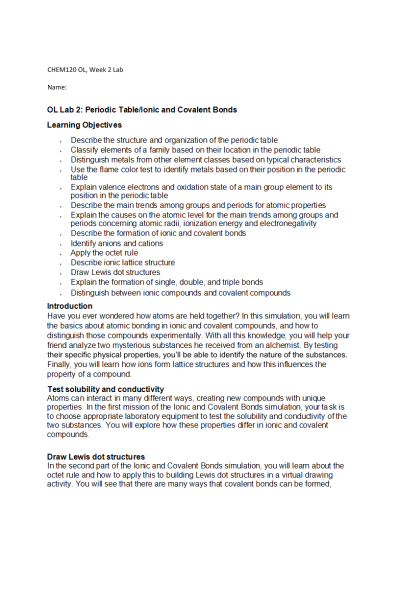CHEM 120 Week 2 Virtual Lab; Part I, Part II, Part III
-
$25.00
| Institution | Chamberlain |
| Contributor | Karin Austin |
Document Preview
OL Lab 2: Periodic Table/Ionic and Covalent Bonds Learning Objectives
- Describe the structure and organization of the periodic table
- Classify elements of a family based on their location in the periodic table
- Distinguish metals from other element classes based on typical characteristics
- Use the flame color test to identify metals based on their position in the periodic table
- Explain valence electrons and oxidation state of a main group element to its position in the periodic table
- Describe the main trends among groups and periods for atomic properties
- Explain the causes on the atomic level for the main trends among groups and periods concerning atomic radii, ionization energy and electronegativity
- Describe the formation of ionic and covalent bonds
- Identify anions and cations
- Apply the octet rule
- Describe ionic lattice structure
- Draw Lewis dot structures
- Explain the formation of single, double, and triple bonds
- Distinguish between ionic compounds and covalent compounds
Introduction
Have you ever wondered how atoms are held together? In this simulation, you will learn the basics about atomic bonding in ionic and covalent compounds, and how to distinguish those compounds experimentally. With all this knowledge, you will help your friend analyze two mysterious substances he received from an alchemist. By testing their specific physical properties, you’ll be able to identify the nature of the substances. Finally, you will learn how ions form lattice structures and how this influences the property of a compound.
Test solubility and conductivity
Atoms can interact in many different ways, creating new compounds with unique properties. In the first mission of the Ionic and Covalent Bonds simulation, your task is to choose appropriate laboratory equipment to test the solubility and conductivity of the two substances. You will explore how these properties differ in ionic and covalent compounds.……….. Continue
| Instituition / Term | |
| Term | Summer |
| Institution | Chamberlain |
| Contributor | Karin Austin |





-80x80.JPG)



-80x80.JPG)





























































